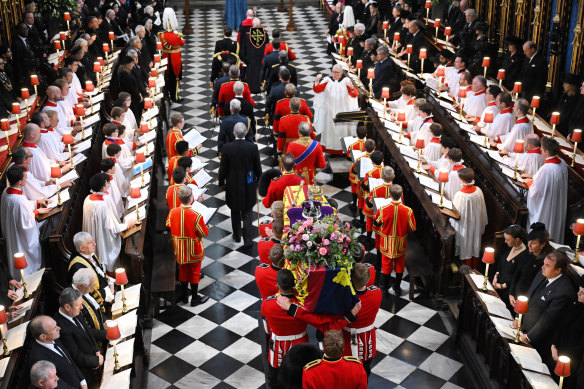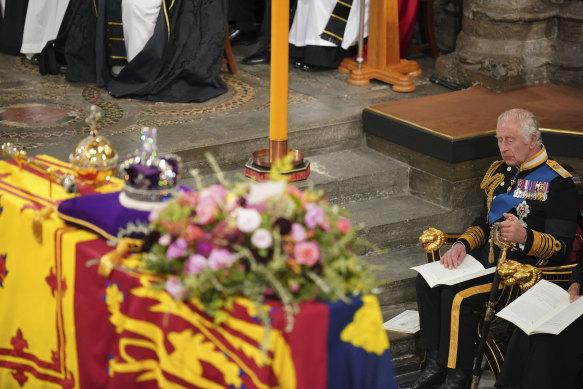London: They came, great ranks of presidents, prime ministers, statesmen and women, kings and queens from afar – even an emperor from Japan – to ancient Westminster Abbey, their passage marked with the tolling of a single bell.
Once every minute for an hour and a half, the abbey’s big tenor bell rang out: 96 times, tolling the years of the life of the Queen the leaders of the world had come to honour and farewell.
It was the beginning of the final act in 10 days of long-distance courtly pageantry since the death at Balmoral Castle, Scotland, of Queen Elizabeth II, the longest reigning of all British monarchs.
Nothing that had gone before, however, could compare with the military and religious grandeur that all but closed London and beyond on Monday.
The Queen’s 70-year reign covered almost all of a complicated and turbulent postwar world. She oversaw the decline and end of the British Empire, which in the first half of last century administered about one quarter of the Earth’s lands and almost 25 per cent of its population.
But Great Britain, reduced now to little more than a gathering of islands off the European continent, reached much further back into its history, traditions and myths to accompany the late Queen to her final resting with her late husband of almost 74 years, Philip, the Duke of Edinburgh.
The coffin is taken into Westminster Abbey.Credit:Getty
If the 2000 mourners in the pews of the thousand-year-old abbey formed an ocean of solemn black, many of the vast military and ceremonial regiments and marching bands brought out to accompany and protect the Queen’s coffin were a shout of scarlet and gold, some of the ornate outfits designed as long ago as the 14th century.
It was a farewell in four parts, taking most of the day.
During the morning there was the state funeral itself in the abbey, followed by the procession of the coffin by gun carriage to Wellington Arch at Hyde Park Corner and then by hearse to Windsor Castle to allow tens of thousands of subjects a final glimpse of Her Majesty’s coffin.
From mid-afternoon there was a committal service within St George’s Chapel at Windsor Castle and finally, privately, the burial of the late Queen alongside her husband in the tiny King George VI chapel, where her parents and her sister are entombed.
King Charles III sits in front of the coffin of Queen Elizabeth II.Credit:AP
It’s five parts if we are to count the short procession of the coffin before the funeral from Westminster Hall, where it had lain in state for four days, allowing hundreds of thousands of citizen-mourners to file by.
Here was a procession whose central tradition goes back no further than the funeral of Queen Victoria in 1901, the year Australia became a federation.
The coffin, laid upon a gun carriage built in the 1890s, was drawn to the abbey by Royal Navy ratings hauling on ropes, accompanied by massed pipers and drummers, their drums draped in black.
This has been the curious way of things since horses harnessed to the carriage are said to have misbehaved at Queen Victoria’s funeral, threatening to topple the coffin. Sailors nearby rushed to the rescue, towing the gun carriage by improvised drag ropes. Thus began a custom that has never been relinquished by the Navy.
Wreaths lay upon the coffin, their flowers and foliage ordered, according to the palace, by King Charles III to be cut from the gardens of royal residences – Buckingham Palace, Clarence House and Highgrove House.
Among the floral arrangements was rosemary for remembrance. Myrtle, symbol of a happy marriage, was cut from a plant grown from a sprig taken from the late Queen’s wedding bouquet in 1947. And English oak represented the strength of love.
The lead-lined coffin, born on the shoulders of strong bearers known as the Service Equerries to the Queen, reached the door of the abbey at the precise moment the last of the tenor bell’s 96 peals rang out.
The Abbey has been central to British royal life since it first rose in 960AD, and has been the seat of British coronations since William the Conqueror invaded in 1066 and had himself crowned king on Christmas Day.
Much of the building was torn down and rebuilt by King Henry III in the 13th century, but its role in Britain’s royal life has remained constant.
It has, too, been paramount to the critical moments in the life and now death of Queen Elizabeth II.
She and Philip, Duke of Edinburgh, were married there in 1947, making Elizabeth the 10th royal bride to be married in Westminster Abbey.
In 1953, Elizabeth was crowned upon its Stone of Destiny and St Edward’s chair, commissioned by King Edward I in 1296.
Now, beneath its soaring, Gothic arches and ribbed vaulting, a world of leaders came for the completion of what we might call the second Elizabethan age,
The late Queen’s eldest son, King Charles III, sat facing the coffin with his Queen Consort, Camilla. Beside them were the Queen’s other children: Princess Anne, the Princess Royal, with her husband Vice Admiral Timothy Laurence; Prince Andrew, Duke of York; and Prince Edward, the Duke of Wessex and his wife Sophie, the Countess of Wessex.
Hymns floated above the throng, and the Archbishop of Canterbury, Justin Welby, delivered a sermon that stressed Queen Elizabeth’s life of service.
“People of loving service are rare in any walk of life. Leaders of loving service are still rarer,” he said.
“But in all cases those who serve will be loved and remembered when those who cling to power and privileges are long forgotten.”
The archbishop said the late Queen’s family was being forced to grieve in the brightest spotlight.
“May God heal their sorrow, may the gap in their lives be marked with memories of joy and life.”
The sermon ended with Welby repeating the Queen’s words used in her Covid lockdown address to the nation.
“We will meet again,” he said.
The Queen of the United Kingdom, of course, was Queen of Australia, and amid the fanfares and the sacred music could be heard the work of an Australian.
As mourners filed into the abbey, they were greeted by the haunting Fantasy on ‘O Paradise’ by the late Australian composer Malcolm Williamson.
Born in Sydney and educated at Barker College in Hornsby, Williamson was Master of the Queen’s Music from 1975.
A sometimes troubled man, he failed to finish a piece for the Queen’s silver jubilee in 1977, putting him out of favour with the British establishment.
No member of the royal family attended his funeral in 2003. But now, the choice of one of his compositions for the Queen’s funeral might be considered an overdue reconciliation.
Receive a wrap of our coverage as the world mourns Queen Elizabeth II in our Morning Edition newsletter. Sign up here.
Most Viewed in World
From our partners
Source: Read Full Article


